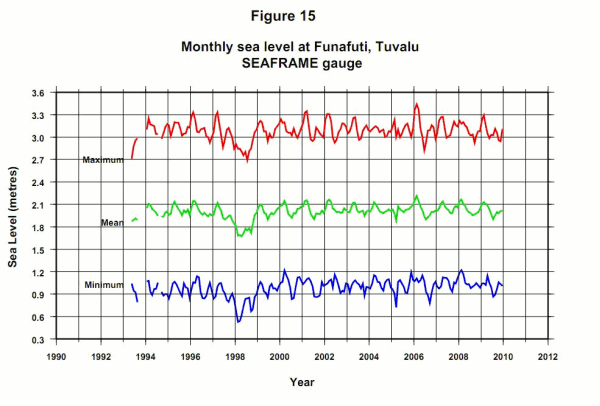The results are shown graphically in their Figure 15 and reproduced here.

Advertisement
These island data have never been published in a "peer reviewed" journal. They are only available on the Australian Bureau of Meteorology website in a series of Monthly Reports, as in the examples given above. Some measure of the reliability and responsibility may be gauged from the disclaimer at the start of the document:
Disclaimer
The views expressed in this publication are those of the authors and not necessarily those of the Australian Agency for International Development (AusAID).
But the names of the authors are not provided.
Advertisement
As you can see, apart from a low in the early records, which seem to be associated with a tropical cyclone, there seems to be no great change in sea level since the early 1990s.
Explaining it away
Vincent Gray explained in his newsletter, NZCLIMATE AND ENVIRO TRUTH NO 181 13th August 2008, that something had to be done to maintain rising sea level alarm, and it was done by in a paper by John R Hunter at http://staff.acecrc.org.au/~johunter/tuvalu.pdf
Hunter first applies a linear regression to the chart for Tuvalu. He gets -1.0±13.7mm/yr so Tuvalu is actually rising! The inaccuracy is entirely due to the ENSO (El Niño-Southern Oscillation) effect at the beginning. He then tries to incorporate old measurements made with inferior equipment and attempts to correct for positioning errors. He gets a "cautious" estimate for Tuvalu of 0.8±1.9mm/yr. He then tries to remove ENSO to his own satisfaction, and now his "less cautious" estimate is 1.2 ± 0.8mm/yr.
Discuss in our Forums
See what other readers are saying about this article!
Click here to read & post comments.
52 posts so far.